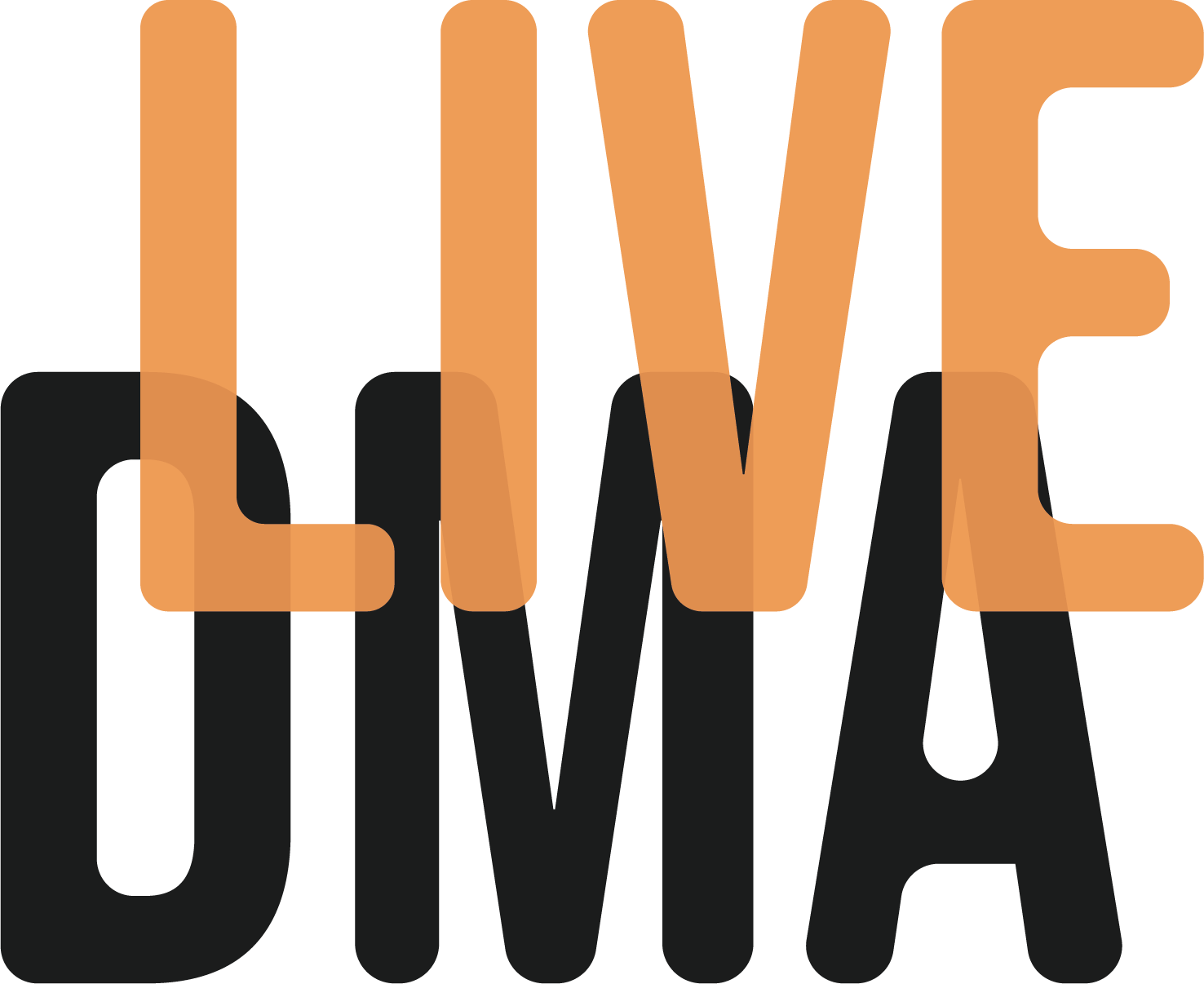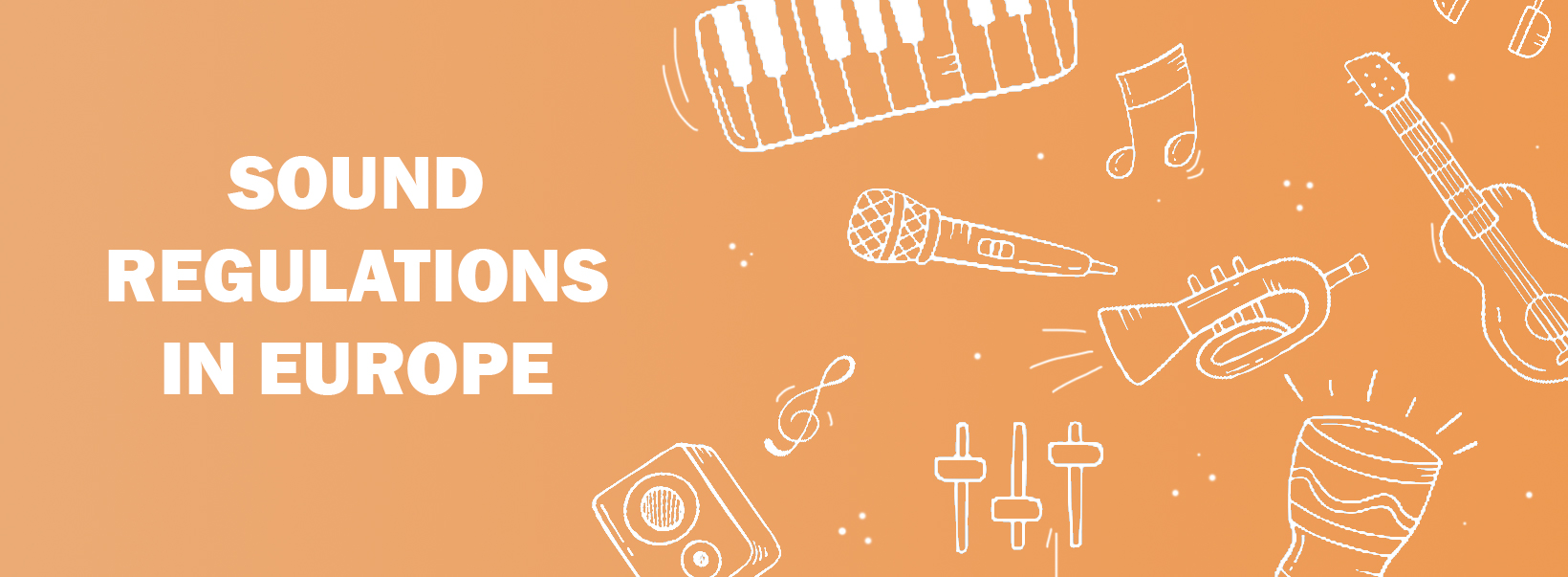
In February 2019, Live DMA organized a Working Group on the topic of sound regulations in Europe. The aim of this Working Group was to achieve an inventory of the various sound regulations ruling the European live music scenes and exchange on the various difficulties these regulations bring to the live music sector. This Working Group highlighted the many disparities in European sound regulations and confirmed the idea that most of these regulations are not adapted to the realities of the sector and they can threaten the diversity and liberties of the music venues, clubs and festivals as well as artistic diversity.
Below, you will find a summary of the information and positions exchanged during the Working Group session as well as technical sheets that detail the sound regulation for each country, feel free to download them!
These facts and perspectives are the result of the Live DMA Working Group session on sound regulations. See the full report here!
SOUND LEVELS INSIDE A VENUE
The regulation of the sound levels inside a venue is meant to protect the hearing of the audience as well as the one of people working in the venue.
In Europe, the sound levels authorized vary from 90 dB(A) to 114 dB(A) with momentary peaks up to 140 dB(C)
Sound is regulated in a strict manner in some countries and only through recommendations in other countries. The duration of the sound exposure is also a criteria taken into account when regulating sound levels. Some countries have to set up periods or places of less than 80 dB(A) for the audience and workers to rest their ears.
SOUND EMISSIONS (OUTSIDE A VENUE)
The sound emissions of a venue is the sound perceived from outside a venue. They are regulated differently depending on what hour of the day or night it is. At night, venues must respect stricter sound regulations than in the day. Some venues even have a curfew after which they cannot emit any music.
PREVENTION
Preserving the hearing health of the audience and the workers inside a venue is crucial. Many venues and live music associations have set (by law or by themselves) some preventions tools, such as:
- Free earplugs available for the audience
- Noise-cancelling headphones for kids from 3 to 12 years old
- Reduced price on moulded auditory protections for staff and artists
- Visual indicators of the sound level (show sound levels in real time or posters informing the public of the hearing risks)
- A quiet space within the venue, club or festival for audiences to rest their ears
Specific attention is given to children’s sound exposure. Some venues also have an age limit and can be forbidden to children under 13.
EXAMPLES OF PREVENTION CAMPAIGNS AND RISK ASSESMENT TOOLS
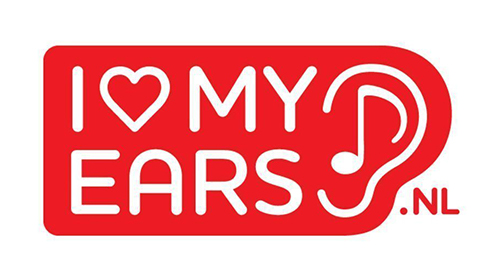
VNPF
In the Netherlands, VNPF took part in a 4 years agreement with the authorities in order to have sound regulations that everybody agrees on.
They also developed the prevention campaign “I love my ears”
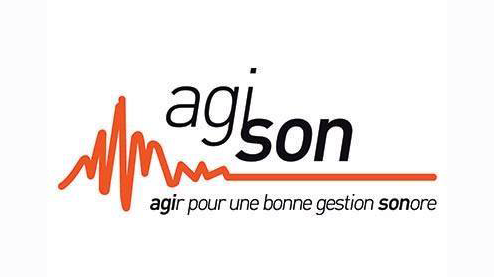
AGI-SON
In France, the association AGI-SON advocates for comprehensive policy making regarding sound regulations.
The association has launched prevention campaigns and offers reduced prices on moulded earing protections for staff.
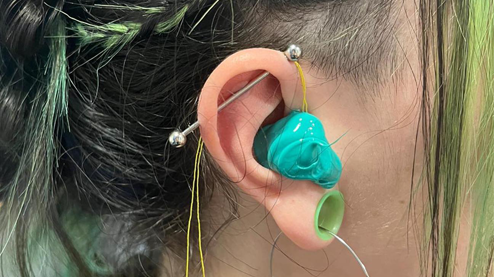
Online Interactive Risk Assessment Tool (EU Agency for Safety & Health at Work)
Discover the Online Interactive Risk Assessment Tool for Live Performances, which allows you to asses risks and gives you a personnalised action plan for safety at work.
WHO CONTROL THE SOUND REGULATIONS?
Most of the time, live music professionals are not part of the policy making that rules their sector, work and everyday life. Sound regulations come from different levels: European national regional or local. They can be in the form of laws, decrees, edicts or recommendations.
CONCERNS OF THE LIVE MUSIC SECTOR
All the music professionals representatives present at the Working Group on sound regulations agree that sound levels need attention. The following opinions came out from these sessions:
ARTISTIC IMPACT
- “The sound reglementations endanger artistic diversity as music genres with heavy bass frequencies are disadvantaged and risk to be less programmed in venues because organising such concerts is more difficult.”
- “Local rules create inequalities among a same country and complexifies touring bands as they need to comply to different reglementations for each different gig”
- “Sound regulations that are too strict might alter the experience of live music and make it nonsensical”.
POLITICAL FRAMEWORK
- “The chain of responsibility is unclear. Are music venues the sole responsible for managing sound emissions?”
- The entities controlling the sound levels are not music professionals and are not competent enough to regulate such issues.”
- “It is very expensive and difficult to implement the reglementation”.
URBAN DEVELOPMENT
- “The densification of population and buildings in European cities is not adapted to the sound regulations”.
- “One individual complaint from a neighbour can close down a venue. It seems unbalanced compared to the many individuals who profit from the benefits of attending a live music show!”
Legal voids in the reglementations: the various laws and recommendations can be interpreted in different ways. What is considered as noise and a nuisance is very subjective.
CHALLENGES THE LIVE MUSIC SECTOR FACES
The European live music sector has multiple challenges to face regarding sound regulations. These challenges are mainly technical and financial: indeed, it is usually very expensive to conform to the law and make a venue 100% soundproof. The solutions proposed by the authorities are often undaptated and costly. Regarding the management of the people once they are outside the venue, no solution has been proposed yet.
If they do not comply to the regulations, live music venues face some risks:
- Penalties and fines
- Restrictions such as the prohibition of organising show for a certain period of time
- Administrative closure
SOUND REGULATIONS IN EUROPE
| Country | Inside the venue | Outside the venue | Complementary measures | Link |
|---|---|---|---|---|
| Belgium | Flanders & Wallonia: 100 dB(A) at 60min Front of House (FOH). Control by measuring Leq. at 15min > 102 dB(A) Brussels: 100 dB(A) and 115 dB(C) at 60min FOH | – Under 85dB(A) @ 60 minutes: no need to do anything – From 85 to 95 dB(A) @ 60 minutes: the responsible of the event/place has to provide earplugs and publicly screen the sound levels – From 95 to 100 dB(A) @ 60 minutes: same requirements + need a person in charge of sound who has gone through a specific training provided by Bruxelles Environnement | Free earplugs available for the audience | READ PDF |
| Catalonia (ES) | 105 dB(A) | – 7am to 9pm: 60 dB(A) – 9pm to 11pm: 60 dB(A) – 11pm to 7am: 50 dB(A) | – Sound limiter in each room sealed by the police and connected to the department of the town hall – Sign at the entrance: “Noise level above 90dB(A). Noise levels within this place can seriously injure the ear” | READ PDF |
| Finland | No straight legal sound regulations. Usually 96-102 dB LAeq (5min), measured at Front of House (FOH). | – Day-time: 65-70 dB – Night-time: 55dB | / | READ PDF |
| France | 102 dB(A) on 15mn 118 dB(C) on 15mn | / | – Record and keep the levels (in dB(A) and dB(C)) every 6 months – Continuously show levels near the sound control system. – Inform the public about the hearing risks. – Provide free hearing protection adapted to the audience. – Create areas (or periods) of audition rest (less than 80 dB over 8h). | READ PDF |
| Galicia (ES) | No straight legal sound regulations. | / | – Include normalised noise isolation to preserve the residential buildings next to the venue: specific checklist to comply to regarding isolation/air conditioning – Free protective earplugs | READ PDF |
| Germany | Recommendation: – 99dB(A) at 30mn. – Maximum peak at 135 dB(C) | – Day-time: 50-65 dB(A) – Night-time: 35 to 50 dB(A) | Sound measurement inside the venue | READ PDF |
| Latvia | No straight legal sound regulations. | Regulations depend on the 5 different area categories of the city: – Day-time: 50-60 dB(A) – Night-time: 40 to 55 dB(A) | / | READ PDF |
| Netherlands | – Agreement signed by VNPF with the department of health: 103 dB(A) at 15mn. – Several labour conditions to respect regarding noise protection | Depends on the municipalities. Fluctuate between 25 dB(A) and 70 dB(A) depending on the hour and the area. | / | READ PDF |
| Sweden | – 100 dB(A) – Presence of kids under 13: 97 dB(A). Kids can come at some festivals if they wear ear protection | / | Measurement of sound level | READ PDF |
| Switzerland | Regulations depends on the 26 cantons. – Unamplified sound is not yet subject to any obligation. – Limit value is 100dB(A) average per hour – The momentary value must never exceed 125dB (A) at any time Regulations also depends on the categories of events. | / | Depends on the categories of events: – Information about the hearing risks – Free hearing protection available – Monitoring of the noise level – Autorisation for limitation must be requested – Soundsystem doesn’t last for more than 3 hours – A 85 dB(A) zone must be set-up – Record of the sound level | READ PDF |
| United Kingdom | For the workers: – 87 decibels for daily or weekly personal noise exposure (LEP,d or LEP,w) – 140 decibels for peak sound pressure (LCpeak) For the audience: no specific legislation but recommendations: – the A-weighted equivalent continuous sound level over the duration of the event (Event LAeq) in any part of the audience area should not exceed 107 dB, and the C-weighted peak sound pressure level should not exceed 140 dB | Depends on the venue category: from 15 dB(A) to 725 dB(A) | – Audience not allowed within 3m of loudspeakers – Hearing risks information for event above 96 dB | READ PDF |
